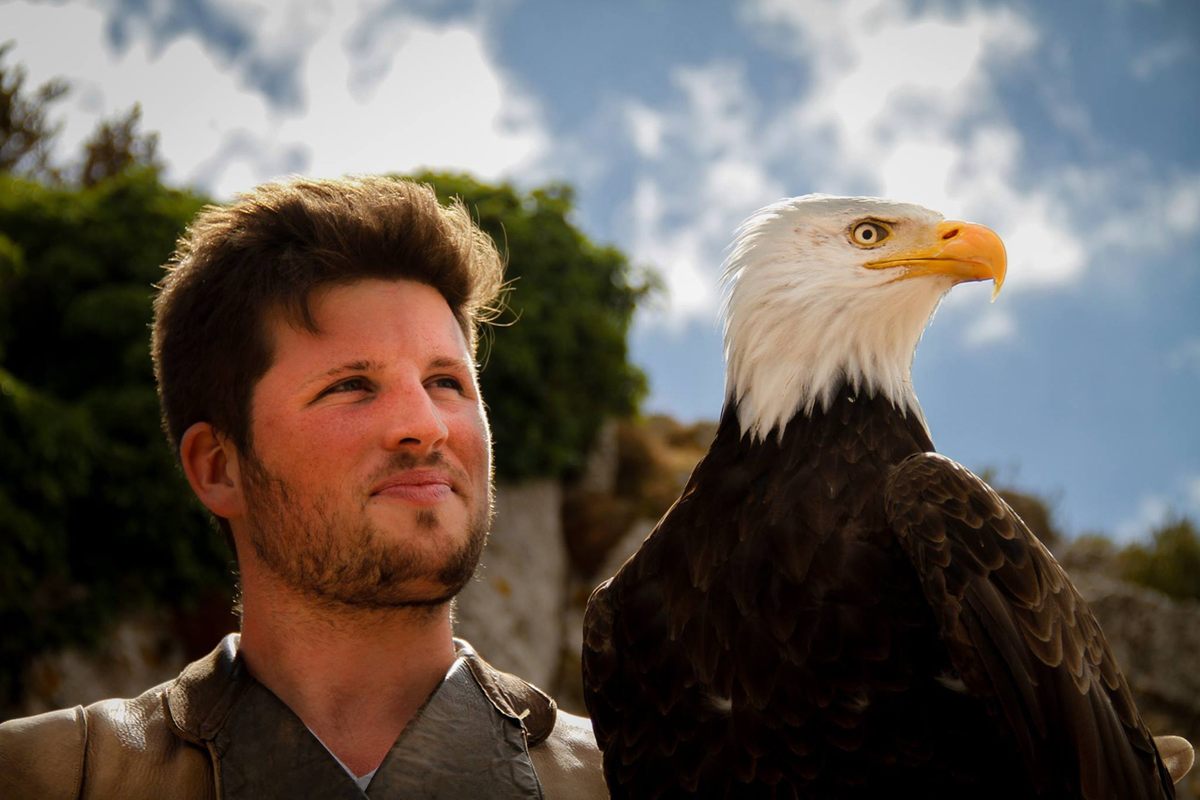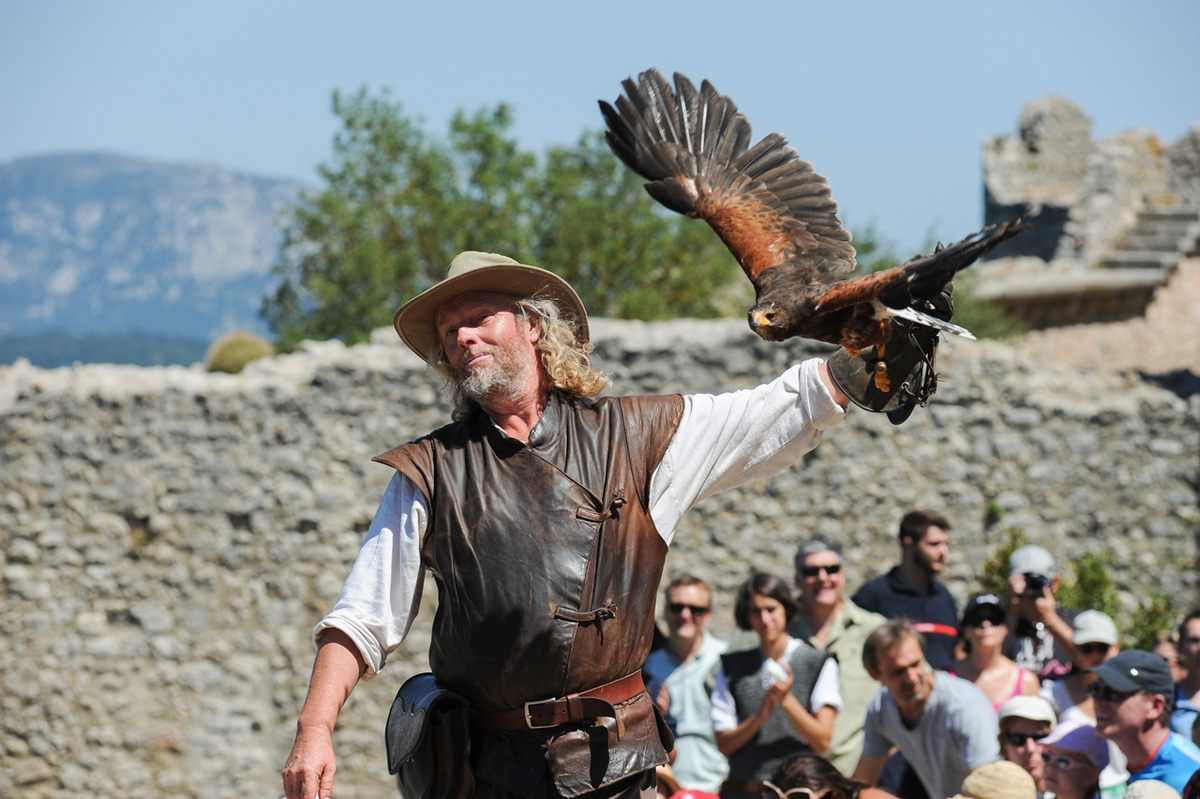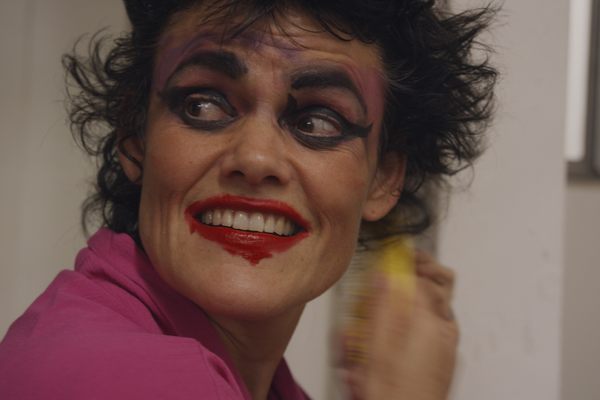
These French Falconers Are a Family Act
Their diverse, globetrotting work is equal parts science and spectacle.
High above the southern French village of Duilhac, Patrice Potier and his son Simon are standing in the ruins of the Peyrepertuse castle, narrating a feast for the eyes. As 2,000 spectators watch, nearly a dozen birds of prey are swooping up and down the cliffside, disappearing from view only to return and land on an outstretched arm.
This 13th-century castle, built more than 2,500 feet above the ground below, is perfectly positioned for such a spectacle. Two winds intersect here, and no matter which one is blowing on any given day, the Potiers’ birds can always soar.
“You witness flights here that you won’t witness anywhere else in the world,” says Patrice. “Each and every time, I get emotional seeing an eagle fly, a falcon fly, this way. And I’ve seen them fly a thousand times.”
Patrice has been a professional falconer for 30 years. A consummate showman with a captivating voice and manner, he travels the world for his work, displaying the 60 birds he keeps at his home in Normandy to live audiences, in documentaries, stage plays, and even an opera.
Simon is an avian expert as well, but of a decidedly different feather: The younger Potier is one of the foremost scholars in Europe on birds of prey.

Together, the father-son falconry duo create shows such as this one at Peyrepertuse for festivals and fairs all over France.
Falconry is first and foremost a hunting practice that dates back over 4,000 years. Falconers train birds of prey—usually falcons, but also hawks, eagles, and owls—to seek out small game and bring it back to the falconer, who can receive a landing bird on his or her arm thanks to a leather gauntlet or glove that protects the skin. Leather hoods are used on the birds during training and transportation to prevent them from being distracted (in fact, the term “hoodwinked” may have come from 16th-century falconry terminology for this practice). Bells, meanwhile, are often attached to the bird’s legs to help the falconer find a bird in the sky, and some modern falconers even use GPS tracking devices.
Today, according to Veronique Blontrock of the International Association of Falconry, tens of thousands of falconers around the world belong to clubs and associations dedicated to the sport. But she notes that there are possibly tens—or even hundreds—of thousands more who practice the sport “not secretly, but discreetly,” especially in countries where falconry is not governed by laws and regulations. In Europe, she says, about 10,000 people openly practice the sport.
For Patrice, it all started with a common buzzard.
Growing up in housing projects in Verdun, he was lucky enough to live next door to a 27,000-acre wood filled with birds. When he was 12, he stumbled upon a buzzard that had fallen out of its nest.

“I picked it up and I fed it, and I raised it,” he recalls. “And then … well, I made a lot of mistakes.”
He managed to get the bird to follow him on walks, but about a month later, lacking the appropriate training, it flew away.
It wasn’t until 10 years later that Patrice would acquire his next bird—a northern goshawk—after an encounter with Jean-Louis Liegeois, a forest ranger experienced in hunting with birds of prey. After meeting Liegeois through his wife’s cousin, Patrice expressed interest in the older man’s passion for falconry. The two hit it off, and soon Patrice began accompanying Liegeois on hunts. Together their birds snared small game—rabbits, hares, pheasants, wild ducks—though almost never to be the men’s supper.
“In falconry, there’s an ethic,” says Patrice. “The bird isn’t hunting for you; he’s hunting for himself. When he catches something … the least you can do [is] let him eat.”
At the time, falconry was a hobby for both men. But they would both eventually turn it into a career. Liegeois would go on to become director of the Falconry Academy of the Puy du Fou, a historical theme park (the second-largest in France after Disney). Potier, meanwhile, found work at a wildlife park, where he applied his newfound knowledge to the development of his own show—the first spectacle of falconry on horseback to grace French stages.
In a way, the show harked back to an earlier time in France, when horses and falconry were closely connected—at least among the aristocracy. In the first half of the 17th century, King Louis XIII kept 300 birds of prey, and in the ensuing decades, French aristocrats and nobles frequently hunted on horseback accompanied by peregrine falcons, known for their speed.

“They soar so high that at a certain point you can’t see them at all,” says Patrice. “That helps them return to earth at breakneck speeds. At the time [there was an expression] that in going so high, the falcon was becoming closer to God. And only they—the nobles—could use such a bird, who came so close to God.”
But after the French Revolution, falconry fell out of fashion due to its association with the recently deposed nobility. French falconers who hunted in the following centuries often did so in secret.
But what’s old is new again, and falconry eventually came back into vogue. In 1954, it was legalized by the French government, and in 2010 formally protected by UNESCO as an intangible world heritage.
Today, Patrice regales his audiences with these rich historic tales. But unlike his peers—there are about 70 in France, by his estimate—his stories tend to focus equally on modern scientific issues like biodiversity and animal conservation.
“It’s required, in France,” says Liegeois. “We’re required to talk about biodiversity; we’re required to talk about conservation. But at the end of the day, very, very few people actually do it.”
These are apt and timely topics: In France, agricultural pollution is afflicting many species, including prey animals. Falcons and other hunting birds are quickly becoming endangered. Patrice editorializes frequently, telling audiences that French farmers should stop using chemical pesticides, to protect the country’s agrarian ecosystem and reduce the impact on the environment. With his captivating voice and natural showmanship, he keeps his audiences enthralled.

Simon grew up listening as well. Now a postdoctoral fellow in zoology at the University of Lund who publishes papers in peer-reviewed scientific journals, Simon was exposed to his father’s dual passions—birds of prey and ecology—at an early age. But Patrice says he never expected his son to follow in his footsteps.
“I hadn’t planned anything for my children,” says Patrice, “except that they should be happy.”
When they were young teenagers, Simon and his brother Maxime often worked with their father, helping to train Patrice’s birds at their home in northern France. But while Maxime was attracted to water rather than air—today he works in river conservation—Simon found his father’s passion contagious.
When he was 16 they performed their first show together—a spectacle set to the music of Claude Nougaro, against the majestic backdrop of the Corbières mountains. Patrice says that afterward Simon was overcome with emotion, tearfully repeating, “It was beautiful, wasn’t it? It was beautiful, what we did.”
After one of their shows, Patrice remembers going horseback riding and encountering Simon in the mountains, alone with a bird he had trained. “I found it so moving,” Patrice recalls.”To see him alone in the mountains, just letting his bird fly.”
Today, Simon’s passion informs his research, which focuses on visual acuity in birds of prey. He carries out all of his experiments—such as exploring how birds stabilize their heads in flight, and delving into the mechanics of their depth perception—at his father’s home, 45 minutes from where he lives with his wife.
“I’m linking [falconry], now, with issues of conservation—notably problems with collisions with windmills or electric lines,” Simon says. “Understanding how [birds of prey] perceive them and how we can make adjustments, so that the birds can see them better.”
Simon’s passion and work help inform Patrice’s show script, which includes some of the latest scientific research. Simon says that audiences today are more interested and receptive to their message than they were 15 years ago, when he first began working with his father. Simon’s access to the latest research allows them to update their script on the fly.
For instance, says Liegeois, “People used to say, ‘This eagle I’m showing you sees eight times better than you.’ And Simon actually proved, scientifically, that it’s not eight times. It’s two and a half. So [some professionals in the industry] corrected [their] scripts. [They] changed what [they] say.”
Today the father-son team work in a host of venues and formats. They’ve collaborated with robotics experts, for instance, to see if the locomotion used by birds of prey can help develop better flight patterns for drones. They’ve also provided trained birds for artistic endeavors. Patrice recalls his experience working on the documentary film Un Matin sur terre, which filmed sunrise in three different parts of the world. For the segment on the Arctic, Patrice’s snowy owl was the star (a role it got to play only after it had traveled to Norway as checked baggage).

Patrice even supplied a massive crow for an opera. “The crow was supposed to come out just as the last note rang out, in the last act,” recalls Patrice with a laugh. “So the conductor would give the sign. And the crow understood! Soon, it wasn’t about me, in the wings. I didn’t need to call him. As soon as he saw the conductor, he came out! We did 30 shows, and he never made one mistake.”
Patrice and Simon say they love their varied work, which takes them around the world and into exciting encounters and circumstances. But as time goes on, Patrice finds himself identifying more and more with conservationists who question the ethics of keeping such majestic birds in captivity. He says that when people concerned with animal welfare approach him after shows, he can’t help but agree with them.
“They come up and say, ‘A bird of prey doesn’t belong in a medieval festival on a perch. It should be in nature.’ What do you want me to say? They’re right. The older I get, the more I think about conservation and reintroduction of birds into nature. And not so much about having them at home. I don’t know if I’m right … but that’s what feels right.”
Simon says, “My father is a bird-lover before [he’s] a falconer. And he brought me up with that love. Seeing them in nature … that’s our first passion.”
Patrice agrees: “I can’t take a walk without looking into the sky, to see if there’s a bird of prey up there. It’s not something I really think about. It’s not really … calculated. It’s just normal.”
























Follow us on Twitter to get the latest on the world's hidden wonders.
Like us on Facebook to get the latest on the world's hidden wonders.
Follow us on Twitter Like us on Facebook